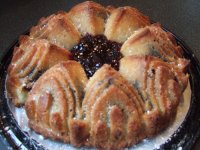Photo above shows the very first homemade
hopia I sunk my teeth into.
As promised, I am posting here today the dough for
hopia. Thanks to
these two recipes that gave me the idea on how to make this pinoy favorite snack that I have missed so much. When my older son tried it, he said that the dough was very much like that of the eng bee tin hopiang ube that I made him taste several days ago, but I noticed the big difference in taste because of 100% ube haleya I used here (the bought one just did not taste quite like the hopiang ube I used to buy back in the Philippines. I don't know if eng bee tin has changed their recipe). The only thing is that the underside is quite thick because of several layers of dough, but it was not too bad once baked.
Just like in one of the above links, I used lard in making the dough. But I used my homemade
pork lard. My Nanay has taught me how to render the fat of some meat to use for sauteeing, and I learned how to render my own pork lard when I came to the US. Others might say "ew!" but nothing beats pork lard when it comes to flaky pie crust. Besides, it is very mildly sweet scented with the flavor of pork fat, it is so subtle and pleasant. Every year, I make this after our pig has been slaughtered, so I know where the pork came from, how it was raised, what it ate during its lifetime. In other words, my pork source would be the envy of a lot of real food foodies. You want to question the health implications for this? Here is a quote coming from my previous correspondence with
fanatic, a nutritionist by profession.
My opinion about pastry ... there's nothing better than lard for making pastry (with a little butter for flavor). Lard is almost 100 percent fat, where butter is only about 80 percent fat, the other 20 percent is protein and moisture. Butter's moisture (water) makes it a poor choice for pastry (when used exclusively), since water will form gluten when it comes in contact with flour ... making the final product chewy instead of flaky.
I stay away from vegetable shortening. Even though it has about the same fat content as lard (making flaky pastry), the trans fatty acids from the process of hydrogenation are now supposedly more of a health concern than the saturated fat in lard. Shortening is pretty tasteless too.
The lard I can purchase here, believe it or not, is hydrogenated. It also contains BHA and BHT (known carcinogens) as preservatives. It's hardly a product I would consume. You deserve a pat on the back for rendering your own lard!Just yesterday I purchased a new product. It's an organic non-hydrogenated shortening, made from palm oil. Palm oil is very saturated naturally, so it's more solid at room temperature.
Another benefit of using animal fat (lard) for use in cooking ... it has a high smoking point so you can brown with it and it will not break down (oxidize). Most vegetable-based liquid oils cannot be exposed to high temperatures without oxidizing, and oxidized (rancid) fat is carcinogenic. And as your Nanay says ... fresh lard tastes better. I think you need to weigh the costs and benefits of the fat you plan on using.In the end, as long as you eat in moderation and are relatively active in life, I don't believe small amounts of animal fat are deleterious.
With that said, I present to you my recipe for a special
hopia dough (I have a hunch that the same practice is done by hopia makers in the Philippines.) If you want, you may use shortening or vegetable lard. If you are interested to make your own, feel free to approach the butcher in your grocery store to inquire. They might even give this to you for free. You can freeze pork lard to keep them fresh longer. Thaw in the fridge when you are about to use. I also use it nowadays for
making pie crusts, instead of vegetable shortening.
Ingredients:
Dough 1:1 cup flour
1/4 cup pork lard
Mix together until crumbly (or it appears like coarse meal). Use your hands.
Divide into 4.
Dough 2:Mix together until crumbly (same as in dough 1):
2 cups flour + 1 tbsp sugar
1/2 cup pork lard
Once thoroughly mixed, add
1/2 cup water to the above and mix with your hand. Divide into four. This dough is not really sticky compared to my pie crust dough, but the principles are almost the same.
Once the two are ready, proceed as follows for each part of the two types of dough (which you now have 4 of each):
Use cling wrap above and under dough 2 to make it easier to maneuver. Flatten with rolling pin and shape into a rectangle. Distribute dough 1 above. Roll the two together. Wrap tightly with cling wrap and chill in the fridge for at least 30 minutes.
Note: The contact of water in the above mixture will result to gluten formation. Gluten is what makes dough pliable and chewy. The rest time is necessary for the full development of gluten and making this dough more pliable come rolling and wrapping time. Chilling ensures that dough 1 remains physically "unmixed" with dough 2 despite proximity. The flour+lard (or flour+oil or flour+shortening) in between sheets of flat glutinous dough will create air pockets in between the sheets during baking and the results is hopia pastry with very thin flaky "crust" which is not at all crunchy or hard.
[You might be wondering why I have gloves on. Since working as an RN, I have developed dishidrosis, aka "homemaker's hands" and for me, I can very well call it "nurse's hands" because this condition develops when the hands are subjected to frequent handwashing. My skin gets tiny blisters that itch a lot, then turn flaky and super dry, then they crack and it's ouch! So I try to avoid washing my hands as much as possible. Using gloves and washing them instead of my skin helps me avoid exposure to too much handwashing, especially if I want my cracks to heal before my next duty at the hospital. It's not because I am too particular about "cleanliness" when cooking or baking. It's merely to protect my hands.
Baka sabihin nyo, ang arte ko. Hindi no!]
Final post will be wrapping the filling and baking your
hopia, coming up next.







































